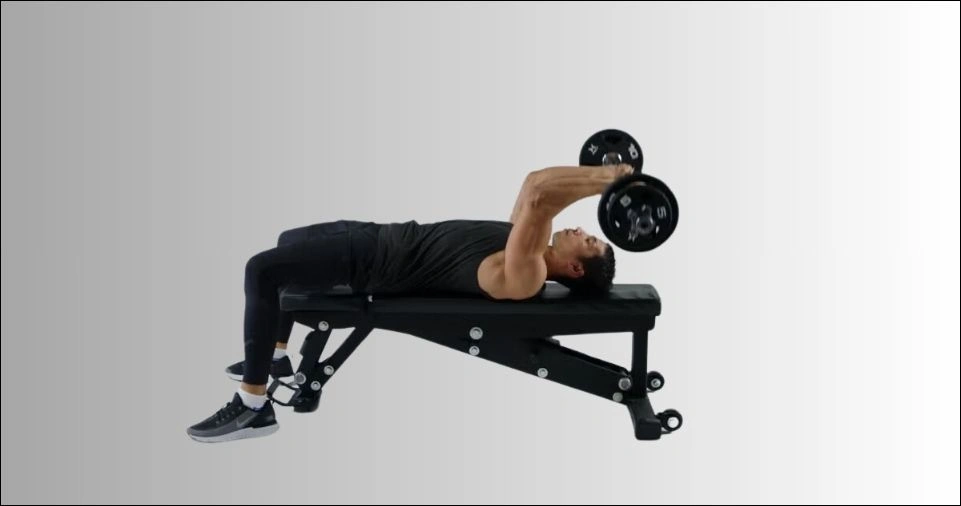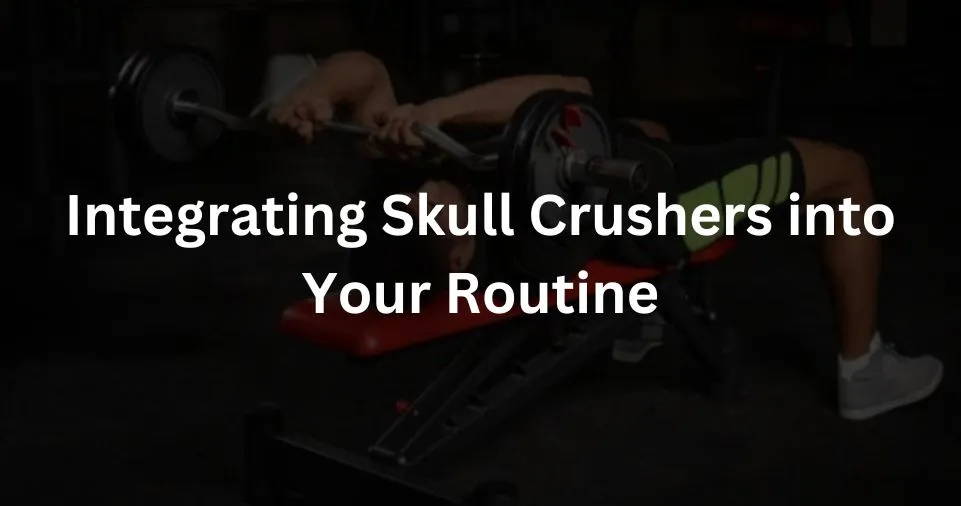Building strong, well-defined triceps is essential for achieving a balanced, muscular upper body. Skull crushers are one of the most effective exercises to target and develop this muscle group.
By incorporating skull crushers into your routine, you’ll not only enhance your arm strength but also improve your overall upper-body performance.
This guide provides a comprehensive look at skull crushers, covering their benefits, variations, proper techniques, and tips for avoiding common mistakes.
Let’s dive into how you can master this exercise and transform your triceps!
What Are Skull Crushers?

Skull crushers, also known as lying triceps extensions, are a highly effective exercise for isolating and developing the triceps brachii muscle.
This movement involves lowering a barbell, dumbbells, or an EZ-bar towards your forehead while lying on a bench, then extending your arms back to the starting position.
Despite their intimidating name, skull crushers are safe and extremely effective when performed correctly.
This exercise is favored for its simplicity and accessibility. You don’t need complex machines or advanced techniques to execute it. Instead, it’s all about focusing on form and controlled movement to maximize its benefits.
Benefits of Skull Crushers

Targeted Muscle Development
Skull crushers isolate the triceps, allowing you to focus solely on strengthening this muscle group. By targeting all three heads of the triceps – long, lateral, and medial – you achieve balanced growth and improved definition. This makes the exercise a must for anyone aiming for symmetrical arm development.
Enhanced Arm Strength
Stronger triceps improve your ability to push and press, benefiting exercises like bench presses, overhead presses, and dips. Improved triceps strength enhances overall upper-body power and performance, especially in sports and functional movements.
Increased Arm Size and Aesthetic Appeal
Consistently performing skull crushers promotes muscle hypertrophy, leading to larger, more sculpted arms. Aesthetic appeal aside, bigger triceps contribute to a stronger, more powerful physique.
Functional Strength
Strong triceps are essential for everyday tasks that involve pushing movements, enhancing overall functional fitness. Whether it’s lifting objects or playing sports, this muscle group plays a pivotal role.
ALSO READ: Learn to Sit Back and Observe. Not Everything Need – Tymoff
How to Perform Skull Crushers Correctly
Step-by-Step Guide
- Setup:
- Lie flat on a bench, feet firmly planted on the ground.
- Hold a barbell, EZ-bar, or dumbbells with an overhand grip, arms extended above your chest.
- Lowering Phase:
- Slowly bend your elbows to lower the weight towards your forehead.
- Keep your upper arms stationary and elbows tucked in close to your head.
- Lifting Phase:
- Pause briefly when the weight is near your forehead.
- Extend your arms to return to the starting position.
- Control and Repetition:
- Perform each repetition with control, maintaining steady movement throughout.
Tips for Proper Form
- Avoid flaring your elbows outward, as this reduces triceps engagement.
- Keep your wrists neutral to reduce strain and ensure better control.
- Maintain a controlled tempo to maximize muscle engagement and safety.
- Focus on breathing; exhale during the lifting phase and inhale as you lower the weight.
Variations of Skull Crushers
Adding variety to your routine prevents plateaus and keeps workouts engaging. Here are some effective skull crusher variations:
Dumbbell Skull Crushers
Using dumbbells enhances unilateral strength and stability. This variation helps address muscular imbalances and improves coordination between arms.
EZ-Bar Skull Crushers
The ergonomic design of the EZ-bar reduces wrist strain, making this variation more comfortable for many lifters. It’s particularly effective for those with wrist mobility issues.
Incline Skull Crushers
Performing skull crushers on an incline bench shifts emphasis to the long head of the triceps, offering a new challenge and stimulating muscle growth in different areas.
Close-Grip Skull Crushers
This variation focuses on the inner triceps, promoting a more complete development. Using a narrower grip emphasizes strength and muscle in this specific area.
| Variation | Equipment Needed | Key Benefits |
|---|---|---|
| Dumbbell Skull Crushers | Dumbbells | Unilateral strength, enhanced control |
| EZ-Bar Skull Crushers | EZ-Bar | Reduced wrist strain |
| Incline Skull Crushers | Incline Bench, Barbell | Targets different triceps angles |
| Close-Grip Skull Crushers | Barbell or EZ-Bar | Focuses on inner triceps development |
Common Mistakes to Avoid
Avoiding these common mistakes will help you get the most out of your skull crusher workouts while minimizing the risk of injury and maximizing effectiveness. Let’s break down each mistake in detail:
Using Excessive Weight
Starting with too much weight not only compromises your form but also puts undue stress on your elbows and wrists.
This can lead to discomfort or long-term injury. Instead of focusing on lifting heavier weights, prioritize mastering your technique.
Begin with a manageable weight and increase gradually as your strength improves. Proper form should always take precedence over heavier loads.
Improper Elbow Positioning
Allowing your elbows to flare out during the exercise diminishes triceps engagement and shifts tension to other muscles like your shoulders and chest.
To maximize triceps activation, keep your elbows tucked in close to your head throughout the movement. A helpful tip is to imagine your elbows locked in place, moving only your forearms.
Neglecting Warm-Up Sets
Skipping warm-up sets is a common oversight that increases the likelihood of muscle strain or joint pain. Warm-ups prepare your triceps and surrounding muscles for heavier loads, improving flexibility and blood flow.
Begin your workout with lighter weights and perform 10-15 controlled reps before progressing to your working sets.
Rushing the Movement
Performing skull crushers with rapid or uncontrolled movements reduces their effectiveness and heightens the risk of injury. Fast movements often lead to momentum-based lifting rather than muscle-focused control.
Aim for a steady tempo: lower the weight slowly (eccentric phase) and raise it with control (concentric phase). This deliberate pace ensures maximum muscle activation and reduces joint stress.
Poor Grip
An unstable or improper grip on the bar or dumbbells can result in decreased control and efficiency. Worse, it may cause the weights to slip, increasing the risk of accidents. Always ensure your hands are firmly and comfortably positioned.
Use an overhand grip for bars and maintain a neutral grip for dumbbells. If grip strength is a limiting factor, consider using lifting straps or chalk for added stability.
By addressing these common mistakes, you can improve the quality of your workout, enhance triceps development, and reduce the likelihood of injury. Remember, small adjustments in form and execution can lead to significant long-term gains.
Integrating Skull Crushers into Your Routine

Example Triceps Workout
| Exercise | Sets | Reps |
| Bench Press | 4 | 8-10 |
| Skull Crushers | 3 | 10-12 |
| Tricep Pushdowns | 3 | 12-15 |
| Dips | 3 | 8-10 |
| Overhead Tricep Extension | 3 | 12-15 |
Training Tips
- Perform skull crushers after compound lifts to focus on isolating the triceps when they are already fatigued.
- Gradually increase weight and volume to ensure progressive overload, which is essential for muscle growth.
- Incorporate variations to target different parts of the triceps and avoid monotony in your training program.
- Ensure proper recovery by spacing triceps workouts throughout the week.
Overcoming Plateaus
Progressive Overload
To break through plateaus and stimulate consistent growth, gradually increase the weight you lift or the number of repetitions you perform.
For instance, if you’ve been lifting the same weight for several weeks, increase it by 5-10% to challenge your muscles.
Alternatively, increase your reps while maintaining strict form. This progressive overload approach ensures your triceps are constantly adapting and growing stronger.
Another strategy is to adjust your training volume by increasing the number of sets. For example, moving from three sets to four sets can add a new layer of intensity without drastically changing your workout structure.
Supersets and Drop Sets
Supersets involve performing two exercises back-to-back with little to no rest in between, which keeps the muscles under tension for longer periods.
Pair skull crushers with dips or tricep pushdowns for a high-intensity session that maximizes muscle fatigue. For instance:
- Perform 10-12 reps of skull crushers.
- Immediately transition to dips, aiming for 8-10 reps.
- Rest for 60-90 seconds before repeating.
Drop sets are another effective technique. Start with a heavier weight and complete as many clean reps as possible, then reduce the weight by 20-30% and continue the set to failure. This method pushes your muscles beyond their comfort zone, fostering greater hypertrophy.
Experiment with Variations
Plateaus often occur due to repetitive movement patterns. Mixing up your technique can keep your workouts engaging and effective. For example:
- Switch to incline skull crushers to emphasize the long head of the triceps.
- Use dumbbells instead of a barbell to increase stabilization requirements and activate different muscle fibers.
- Try close-grip skull crushers to target the inner triceps for more detailed muscle definition.
Each variation challenges your muscles in unique ways, promoting continuous growth and preventing boredom. Incorporate one or more of these variations every few weeks to ensure your training remains dynamic and effective.
Nutrition for Triceps Growth
Proper nutrition fuels muscle repair and growth. Focus on a diet rich in these essential nutrients:
| Nutrient | Role | Sources |
| Protein | Muscle repair and growth | Chicken, eggs, tofu, whey protein |
| Carbohydrates | Energy for workouts | Sweet potatoes, oats, quinoa |
| Healthy Fats | Hormonal balance, joint health | Avocados, nuts, olive oil |
| Vitamins & Minerals | Supports muscle function and recovery | Leafy greens, citrus fruits |
| Water | Hydration and metabolic processes | Plain water, electrolyte drinks |
To maximize results, eat balanced meals and ensure you’re consuming sufficient protein to support triceps recovery and hypertrophy.
Safety Precautions
- Start Light: Begin with manageable weights to master form and avoid injury.
- Warm Up: Prepare your muscles with dynamic stretches and light cardio to reduce the risk of strain.
- Use a Spotter: When lifting heavy, having a spotter ensures safety and confidence.
- Monitor Joint Health: Avoid discomfort or strain in elbows and wrists by maintaining proper form and using appropriate weights.
ALSO READ: Netwyman Blogs: Your Go-To Guide for Mastering the Digital World
Tracking Progress
Key Metrics to Measure
- Strength Gains: Track increases in the weight you lift over time.
- Triceps Size: Use a tape measure to monitor arm growth periodically.
- Performance Improvements: Note progress in other triceps-related lifts, such as bench press or dips.
Record-Keeping Tips
- Keep a workout journal to log sets, reps, and weights. Reflect on your progression and identify areas for improvement.
- Take progress photos periodically to visualize changes and stay motivated.
Conclusion
Skull crushers are a cornerstone exercise for anyone looking to build insane triceps. By mastering proper technique, experimenting with variations, and integrating them into a balanced workout plan, you’ll develop stronger, more defined arms.
Pair consistent training with proper nutrition and recovery, and you’ll achieve impressive results in no time. Start incorporating skull crushers into your routine today, and watch your triceps transform!

